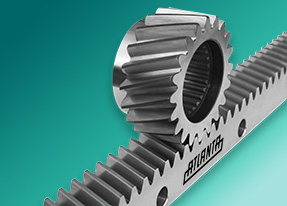When designing a linear motion system for your machine there are many things to consider. Function, precision required, configuration, reliability, and ease of integration are just a few.
There are many different technologies that can produce linear motion. Most have specific advantages that are beneficial for specific applications, although they may not be optimal for others. However, many of these technologies have overlapping capabilities, which means you have to choose.
Two such technologies are ball screws and rack and pinion systems. Each has it’s own well known advantages, but there are many instances when they can do similar jobs, say in applications needing a decent level of positional accuracy over lengths of 3 to 20 feet.
Ball screws are seemingly more often selected for these types of applications, possibly because they are more prevalent and knowledge of rack and pinion is not as wide spread. For consideration of rack and pinion systems as replacements for ball screws, here are 5 reasons they could provide advantages.

Speed – Ball screws can be fast, but simply put, rack and pinion systems can provide much higher linear speed, often by a wide margin. If there is a desire to reduce cycle time, ball screws have limitations that only get worse as the lengths get longer.
Driving screws faster to increase linear speed can result in higher heat generation at the ball nut connection, which affects life. Higher speeds can also result in screw whip, especially in long spans between bearing supports, which can induce vibrations in the system and affect accuracy.
A single revolution of a pinion in a rack and pinion system can generate multiple inches of linear motion instead of fractions of an inch. So you can get where you want to go a lot quicker. And when using ground rack the positional accuracies can be remarkably similar.
Cost – As lengths get longer and force requirements get larger precision ball screws become more and more expensive, sometimes prohibitively so. Especially when custom end machining or modified nuts are necessary, or when upsizing is necessary to reduce whip or buckling forces.
Rack and pinion, on the other hand, can provide high levels of positional accuracy at a relatively reasonable cost. The complexity in manufacturing the components is far less and the performance over longer lengths can be more reliable.
Leadtimes – Since virtually every ball screw application requires a custom length and end finishing, delivery times can be quite long. It isn’t uncommon for it to take from several weeks up to a couple dozen weeks to get a custom ball screw assembly.
Rack and pinion systems, on the other hand, can often be delivered from stock components, with only the last piece of rack in the system requiring a simple cut. Precise racks lengths often aren’t critical, as are ball screw lengths, making in-time acquisition a much more reliable proposition.
Integration – While misalignment is anathema in almost all linear motion systems, it is especially problematic for ball screws. Unless loaded, ball screws do have some clearance and backlash in the nut to screw connection. But tolerances are still small. With the need to add screw support bearing systems to maintain parallelism to the guides, tolerance buildup of the additional structure has to be accounted for.
Racks are typically mounted to the same structure as the linear guides supporting the load. With the same base line, and a small amount of tooth clearance between the pinion and the rack, maintaining proper alignment between the drive and the guide is more easily accomplished.
Life – Both systems require adequate lubrication to achieve their rated performance. That is a given. But ball screws are only rated for a million cycles or so. Of course, most last much longer, especially if not fully loaded. And like most mechanical devices, longer life can be achieved through the use of different materials or upsizing the components.
In comparison, rack and pinion systems, when sized and mounted properly and adequately lubricated, can last for hundreds of millions of cycles before needing replacement. This difference in long term performance can pay for itself many times over.
Conclusion – Ball screws are still king and most appropriate in a wide variety of applications. Shorter strokes, smaller and more precise movements, and where the drive and guide systems are separate, are just a few examples. But where ball screws and rack and pinions systems can both provide the reliable linear motion necessary, a rack and pinion system can offer a lot of benefits over the alternate technology.
ATLANTA Drive Systems is a world leader in rack and pinion system technology offering the widest range of precision levels, sizes, configurations, and optional system components. For more information visit www.atlantadrives.com.
Author: Chris Popp is the principal of C. Popp Enterprises, a manufacturer representation company, and the Midwest Territory Manager for ATLANTA Drive Systems.